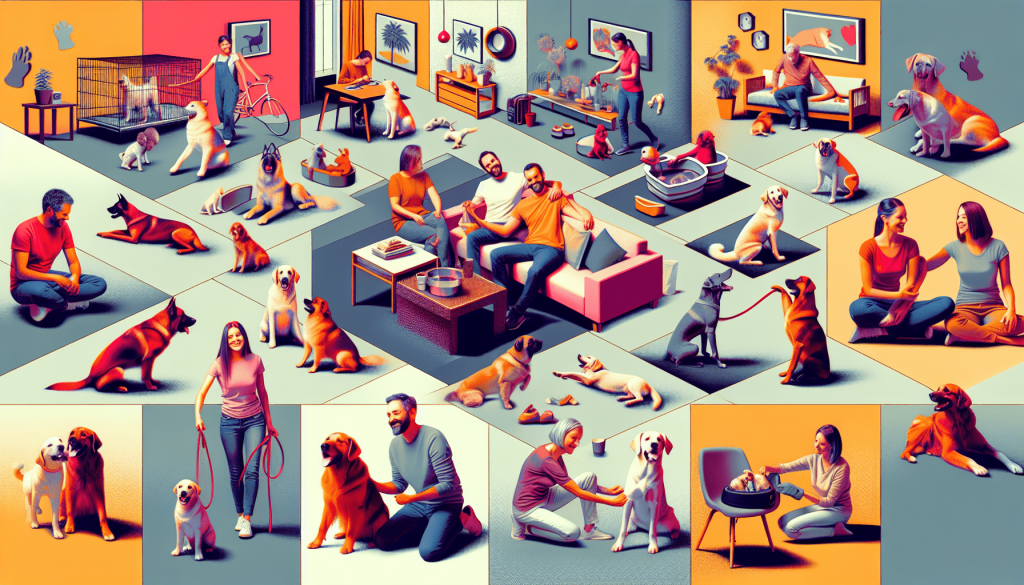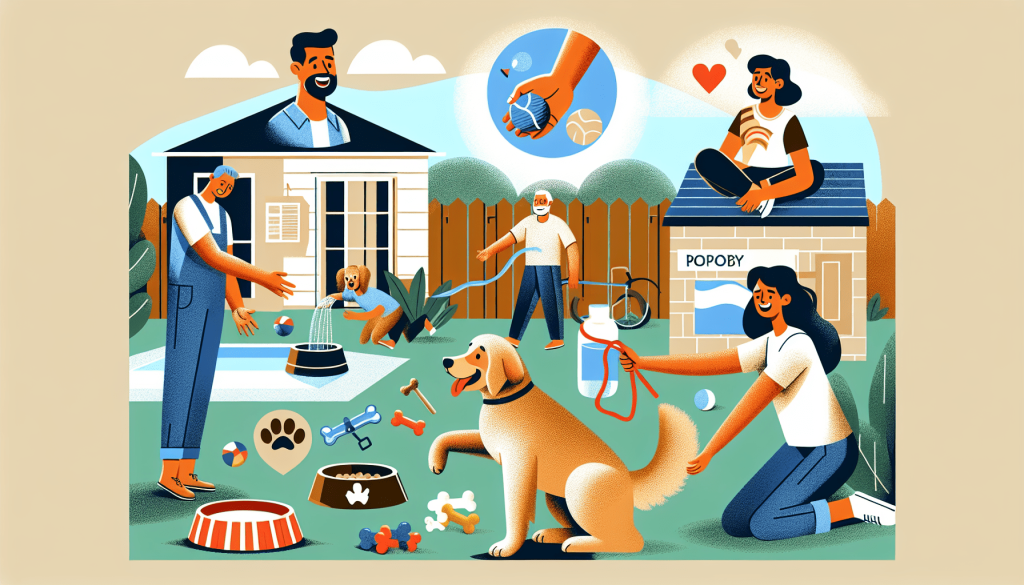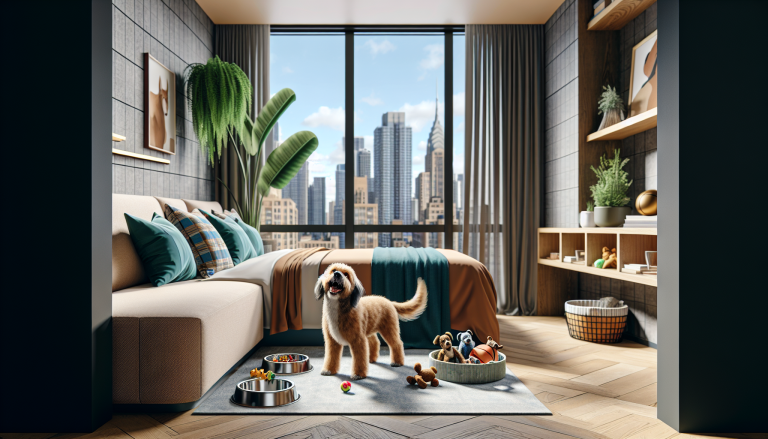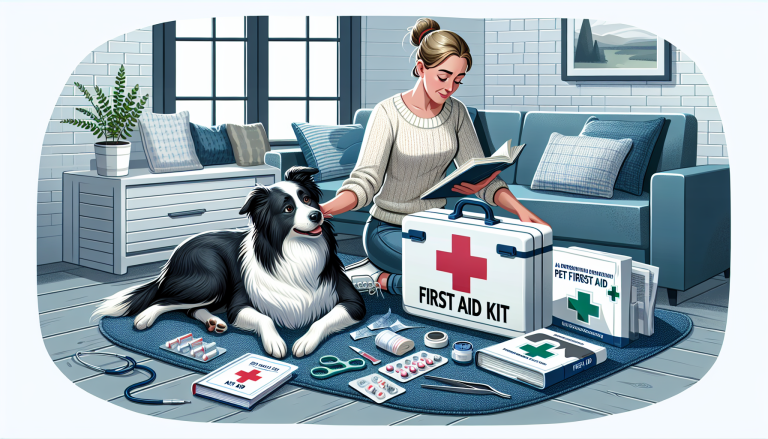So you’re considering getting a furry friend of your own? Look no further! This article has got all the answers to your burning questions about owning a dog. From how to choose the right breed for your lifestyle, to tips on training and socializing your new companion, we’ve got you covered. Worried about the responsibilities that come with dog ownership? Don’t fret, we’ll address those concerns too. So sit back, relax, and get ready to embark on a journey of unconditional love and endless tail wags!
Table of Contents
ToggleChoosing a Dog
What factors should I consider when choosing a dog?
When choosing a dog, there are several factors to consider. First and foremost, you should think about your lifestyle and the amount of time you can devote to a dog. Different breeds have varying exercise and attention needs, so it’s important to choose a dog that can fit into your daily routine. Additionally, consider the size of the dog and whether you have enough space in your home or apartment to accommodate it. Finally, think about any allergies or sensitivities you or your family members may have to certain breeds.
Should I adopt a puppy or an adult dog?
Whether to adopt a puppy or an adult dog depends on your personal preferences and circumstances. Puppies require a lot of time and effort to train and socialize, so if you have the availability and patience, bringing home a puppy can be a rewarding experience. On the other hand, adult dogs are usually already house-trained and may have basic obedience skills. They may also be more calm and settled than puppies. Adoption can be a great way to give an adult dog a second chance at a loving home.
How do I find a reputable breeder or rescue organization?
Finding a reputable breeder or rescue organization is crucial to ensure you are getting a healthy and well-cared-for dog. Start by doing research online and reading reviews or testimonials. Look for breeders or organizations that prioritize the health and welfare of their dogs. Ask for recommendations from trusted friends, family, or your veterinarian. When contacting breeders or rescue organizations, ask about health guarantees, the breeding or rescue practices, and any necessary documentation. Visiting the breeder or organization in person is also recommended to assess the living conditions of the dogs.
What are the best dog breeds for families?
The best dog breeds for families depend on factors such as the size of your family, the age of your children, and your lifestyle. Some popular breeds known for their family-friendly nature include Labrador Retrievers, Golden Retrievers, Beagles, and Bulldogs. These breeds are typically gentle, patient, and good with children. However, it’s important to remember that individual temperament can vary, so it’s essential to spend time with a dog before bringing them into your family to ensure compatibility.
What type of dog is suitable for apartment living?
Living in an apartment doesn’t necessarily mean you can’t have a dog. Many breeds can adapt well to apartment living as long as they receive sufficient exercise and mental stimulation. Small and medium-sized breeds like French Bulldogs, Cavalier King Charles Spaniels, and Shih Tzus are often well-suited for apartment life due to their moderate activity levels and adaptability. However, it’s essential to consider the dog’s exercise needs and whether you have access to outdoor spaces for walks and playtime.
Preparing for a Dog
What supplies do I need for a new dog?
Before bringing a new dog home, it’s crucial to have all the necessary supplies ready. These include:
- Food and water bowls
- High-quality dog food appropriate for their age and breed
- Collar and identification tags
- Leash
- Bed or crate
- Chew toys and interactive toys for mental stimulation
- Grooming tools, such as brushes and nail clippers
- Doggy waste bags
- Dog-friendly cleaning supplies
How can I puppy-proof my home?
Puppy-proofing your home is essential to ensure the safety of your new furry friend. Just like human babies, puppies are curious and tend to explore with their mouths. Here are some steps to puppy-proof your home:
- Secure loose electrical cords and keep them out of reach.
- Store toxic substances, such as cleaning products and medications, in locked cabinets.
- Remove any small objects or choking hazards from the floor.
- Keep garbage cans out of reach or use ones with secure lids.
- Block off any dangerous areas, such as stairs.
- Cover or hide exposed wires.
- Protect your furniture and belongings by using barriers or training methods.
What vaccinations and medical care does a new dog need?
Proper vaccinations and medical care are vital to keep your dog happy and healthy. Consult with a veterinarian to develop a tailored vaccination schedule for your dog based on their age, breed, and lifestyle. Common vaccinations include those for rabies, distemper, parvovirus, and adenovirus. Additionally, regular check-ups, flea and tick prevention, deworming, and dental care are all important aspects of your dog’s overall health. Spaying or neutering is also recommended to prevent certain health issues and unwanted litters.
How do I house train a dog?
House training a dog requires consistency, patience, and positive reinforcement. Here are some steps to help you house train your dog:
- Establish a routine: Take your dog outside to the same spot at regular intervals, such as after meals, naps, or playtime.
- Reward good behavior: When your dog eliminates in the appropriate spot, praise and reward them with treats or verbal cues.
- Supervise and confine: Keep a close eye on your dog indoors and use a crate or a designated area when you can’t supervise them. Gradually increase their freedom as they demonstrate good habits.
- Clean up accidents properly: If accidents happen, clean them up using enzyme-based cleaners to remove odors and discourage repeat accidents.
- Be patient: House training takes time, and every dog learns at their own pace. Stay consistent and avoid punishment, as it may undermine training progress.
How can I help my dog adjust to their new environment?
Adjusting to a new environment can be a stressful experience for a dog. Here are some tips to help them settle in:
- Create a safe space: Set up a designated area in your home where your dog can retreat to feel secure, such as a crate or a quiet corner with their bed.
- Maintain a consistent routine: Dogs thrive on structure, so establish a daily routine for feeding, exercise, and rest.
- Introduce slowly: Introduce your dog to new people, animals, and environments gradually, allowing them to become comfortable at their own pace.
- Provide mental stimulation: Engage your dog with interactive toys, puzzles, and training exercises to keep their mind occupied and prevent boredom.
- Show patience and love: Be patient with your dog as they adjust to their new surroundings. Provide plenty of affection, praise, and positive reinforcement to build trust and strengthen the bond between you.
Feeding and Nutrition
What type of food should I feed my dog?
Choosing the right food for your dog is essential for their overall health and well-being. Opt for high-quality dog food formulated for your dog’s specific age, breed, size, and any special dietary needs they may have. Look for foods that list meat as the main ingredient and avoid those with excessive fillers or artificial additives. Your veterinarian can provide guidance on selecting the most appropriate diet for your dog’s specific requirements.
How often should I feed my dog?
The frequency of feeding depends on your dog’s age and size. Puppies generally require more frequent meals than adult dogs. As a general guideline:
- Puppies under six months: Three to four small meals a day.
- Puppies six to 12 months: Two to three meals a day.
- Adult dogs: Typically two meals a day.
Stick to a consistent feeding schedule to help regulate their digestion and prevent overeating. Avoid free-feeding, where food is left out all day, as it can lead to obesity and behavioral problems.
Are there any human foods dogs should not eat?
Yes, there are several human foods that can be harmful or toxic to dogs. Some common ones to avoid include:
- Chocolate, caffeine, and anything containing xylitol (found in sugar-free gum and candy)
- Grapes, raisins, and currants
- Onions, garlic, and chives
- Avocado
- Alcohol, including beer, wine, and liquor
- Macadamia nuts
- Fatty foods and bones, which can cause digestive upset or pose a choking hazard
If you’re unsure about the safety of a particular food, it’s best to check with your veterinarian before offering it to your dog.
What are the signs of a dog food allergy?
Food allergies in dogs can manifest in various ways. Common signs of a food allergy include:
- Itchy skin, scratching, or excessive grooming
- Digestive issues such as diarrhea, vomiting, or flatulence
- Chronic ear infections
- Red or inflamed skin, hot spots, or rashes
- Hair loss or poor coat condition
If you suspect your dog has a food allergy, consult with your veterinarian. They can conduct tests or recommend an elimination diet to identify the specific allergen and suggest appropriate dietary changes.
Should I give my dog supplements or vitamins?
In most cases, a nutritionally balanced and high-quality dog food should provide all the necessary vitamins and minerals for your dog’s health. However, there may be certain circumstances where supplements or vitamins are beneficial, such as for dogs with specific health conditions or dietary restrictions. It’s important to consult with your veterinarian before giving your dog any supplements, as excessive intake of certain vitamins or minerals can be harmful.
Exercise and Training
How much exercise does a dog need?
The amount of exercise a dog needs varies depending on its breed, age, and individual energy levels. As a general guideline, most dogs require at least 30 minutes to 2 hours of exercise each day. Higher-energy breeds like Border Collies or Huskies may require more intense exercise and mental stimulation to prevent boredom and destructive behaviors. Regular exercise not only helps maintain your dog’s physical health but also contributes to their mental well-being and can strengthen the bond between you.
What are some good ways to keep a dog mentally stimulated?
Keeping a dog mentally stimulated is just as important as providing physical exercise. Here are some ways to keep your dog’s mind sharp:
- Puzzle toys: Engage your dog with puzzle toys that require problem-solving skills to access treats or toys hidden inside.
- Training sessions: Regular training sessions not only reinforce obedience commands but also provide mental stimulation and help build a strong bond with your dog.
- Nose work: Encourage your dog to use their sense of smell by hiding treats or toys and letting them sniff them out.
- Food-dispensing toys: Use interactive toys that dispense treats or kibble as a way to challenge your dog mentally while they work for their food.
- Novel experiences: Introduce your dog to new environments, people, or objects to stimulate their senses and encourage curiosity.
How can I teach my dog basic commands?
Teaching your dog basic commands is an essential part of their training and helps establish clear communication between you. Here are a few steps to get started:
- Begin with simple commands: Start with basic commands such as “sit,” “stay,” and “come.” Use clear and consistent verbal cues along with physical gestures if needed.
- Use positive reinforcement: Reward your dog with treats, praise, or play when they respond correctly to a command. Positive reinforcement helps to reinforce good behavior and motivates your dog to learn.
- Keep training sessions short and fun: Dogs have a shorter attention span, so it’s best to keep training sessions brief and engaging. End each session on a positive note to keep your dog motivated.
- Be patient and consistent: Training takes time and repetition. Be patient with your dog and practice commands in various environments and situations to generalize the learned behaviors effectively.
- Seek professional help if needed: If you’re having difficulties with training or your dog is exhibiting behavioral issues, consider seeking the assistance of a professional dog trainer or behaviorist who can provide guidance tailored to your dog’s specific needs.
What should I do if my dog displays behavior problems?
If your dog displays behavior problems, it’s important to address them promptly to prevent them from escalating. Common behavior problems include aggression, separation anxiety, excessive barking, or destructive chewing. Here are some steps to take:
- Identify triggers and patterns: Observe your dog’s behavior and try to identify any specific triggers or patterns that may be contributing to the problem.
- Consult with a professional: Reach out to a certified dog trainer, behaviorist, or your veterinarian for guidance and professional advice on how to address the specific behavior problem.
- Follow a positive reinforcement approach: Use positive reinforcement techniques to redirect your dog’s behavior and reward appropriate responses. Avoid punishment or harsh training methods, as these can exacerbate the problem.
- Provide appropriate outlets: Ensure your dog is receiving enough physical exercise, mental stimulation, and socialization to prevent boredom or pent-up energy, which can contribute to behavior problems.
- Be patient and consistent: Behavior problems often take time and consistency to resolve. Stay calm, patient, and persistent in your training efforts, and seek professional help if needed.
Are there any effective training techniques for leash pulling?
Leash pulling can be frustrating and make walks less enjoyable. Here are a few training techniques to help address leash pulling:
- Use positive reinforcement: Reward your dog with treats and praise when they walk calmly beside you without pulling. This encourages them to associate loose leash walking with positive experiences.
- Practice leash control: Hold the leash firmly but not too tightly. Avoid pulling back or yanking on the leash, as this can create tension and encourage your dog to pull even more.
- Stop and change directions: When your dog starts to pull, stop walking and change direction. This interrupts their forward momentum and teaches them to pay attention to your movements.
- Use a no-pull harness or head halter: These tools can help provide better control over your dog’s pulling behavior. Consult with a professional trainer or behaviorist to choose the most appropriate equipment and learn how to properly use it.
- Consistency is key: Be consistent and patient in your training efforts. Practice walking on a loose leash in different environments and gradually increase distractions as your dog improves.
Health and Care
How do I prevent fleas and ticks on my dog?
Preventing fleas and ticks is an essential part of your dog’s health care routine. Here are some steps to help keep these parasites at bay:
- Use a flea and tick prevention product: Consult with your veterinarian to choose a safe and effective flea and tick preventive treatment. Options include topical treatments, oral medications, or collars.
- Regularly check your dog: Inspect your dog’s fur and skin for signs of fleas or ticks, especially after outdoor activities. Pay close attention to areas like the ears, neck, and tail where parasites often hide.
- Groom your dog regularly: Regular brushing and grooming help remove any fleas or ticks that may be hiding in your dog’s coat.
- Keep your environment clean: Vacuum your home frequently, wash your dog’s bedding regularly, and keep outdoor areas free of debris to reduce the likelihood of flea or tick infestations.
- Consult with your veterinarian: If you suspect your dog has fleas or ticks, or if you live in an area with a high prevalence of these parasites, consult with your veterinarian for additional prevention strategies or treatment options.
What should I do if my dog gets injured or becomes ill?
If your dog becomes injured or falls ill, it’s important to act promptly. Here are some steps to take:
- Assess the situation: Evaluate the severity of the injury or illness. If your dog is experiencing life-threatening symptoms or severe injuries, seek immediate veterinary care.
- Contact your veterinarian: Reach out to your veterinarian and describe the symptoms or injuries. They can provide guidance on whether immediate veterinary attention is required or recommend first aid measures.
- Administer first aid if necessary: If your dog has a minor injury, such as a cut or scrape, you can clean the wound with a mild antiseptic and apply an appropriate bandage or dressing. However, it’s best to consult with your veterinarian before administering any first aid.
- Follow your veterinarian’s instructions: If veterinary care is required, follow the instructions provided by your veterinarian. This may include giving medications, restricting activity, or scheduling follow-up appointments.
- Provide comfort and support: Keep your dog comfortable and offer reassurance during their recovery. Ensure they have a quiet and safe space to rest, and monitor their progress closely.
When should I spay or neuter my dog?
The optimal time to spay or neuter your dog can vary depending on their breed, size, and overall health. In general, it is recommended to spay or neuter dogs between the ages of six and nine months. However, some larger breeds may benefit from waiting until they are fully mature, around 1 to 2 years of age. Spaying or neutering your dog can help prevent certain health issues, control the pet population, and reduce undesirable behaviors. Consult with your veterinarian to determine the best timing for your individual dog.
How can I groom my dog at home?
Regular grooming is important for maintaining your dog’s coat, skin, and overall hygiene. Here are some tips for grooming your dog at home:
- Brushing: Brush your dog’s coat regularly to remove loose hair, prevent mats, and distribute natural oils. Use a brush or comb suitable for your dog’s coat type and be gentle to avoid causing discomfort.
- Bathing: Bathe your dog as needed using a dog-specific shampoo and warm water. Be careful to avoid getting water in their ears and use a gentle touch. After bathing, thoroughly towel-dry your dog or use a blow dryer on a low setting.
- Nail trimming: Regularly trim your dog’s nails, taking care to avoid cutting into the quick, which can cause bleeding and discomfort. If you’re unsure, consult with a veterinarian or professional groomer for guidance.
- Ear cleaning: Check and clean your dog’s ears regularly to remove dirt, debris, and wax buildup. Use a veterinarian-recommended ear cleaner and gently wipe the outer ear with a clean cloth or cotton ball.
- Teeth brushing: Dental care is important for your dog’s overall health. Brush their teeth regularly using a dog-specific toothbrush and toothpaste. Start slowly and gradually introduce tooth brushing to make it a positive experience for your dog.
What are the signs of a healthy dog?
Monitoring your dog’s health on a regular basis is essential to catch any potential issues early. Here are some signs of a healthy dog:
- Good appetite and weight maintenance
- Healthy skin and coat, free from excessive shedding, redness, or signs of parasites
- Normal energy levels and exercise tolerance
- Clear and bright eyes, without excessive tearing or redness
- Clean ears without discharge or odor
- Regular urination and bowel movements
- Good dental hygiene, including fresh breath and clean teeth
- Alert and responsive behavior, showing interest in their surroundings
- Normal body temperature range between 99.5°F (37.5°C) and 102.5°F (39.2°C)
If you notice any changes in your dog’s behavior, appetite, or physical appearance, it’s important to consult with your veterinarian for proper evaluation and guidance.
Traveling With a Dog
What do I need to know about traveling with a dog by car?
Traveling with a dog by car requires careful planning and preparation. Here are some important things to consider:
- Safety: Ensure your dog is secure during car travel by using a crate, carrier, or a dog seat belt. This helps prevent injuries and distractions while driving.
- Familiarize your dog with the car: Gradually introduce your dog to the car by taking short trips and offering positive experiences such as treats or toys. This helps reduce anxiety and motion sickness.
- Pack essentials: Bring necessary supplies such as food, water, bowls, leash, waste bags, a first aid kit, medications, and any comfort items like blankets or toys.
- Frequent breaks: Regularly stop for bathroom breaks, exercise, and fresh air. Provide your dog with opportunities to stretch their legs and relieve themselves.
- Never leave your dog alone in the car: Even on mildly warm days, the temperature inside a car can quickly become dangerously hot, leading to heatstroke or even death. Never leave your dog unattended in a parked car.
- Plan accommodations: If you’re staying overnight during your trip, ensure that your accommodations are pet-friendly and book in advance.
Can I bring my dog on a plane?
Bringing your dog on a plane requires careful planning and adherence to specific airline regulations. Here are some general guidelines to consider:
- Check airline policies: Each airline has its own rules and regulations regarding traveling with pets. Review their guidelines to understand requirements, restrictions, and any additional fees.
- Health and documentation: Ensure your dog is up to date on vaccinations and obtain any necessary health certificates or documentation required by the airline or your destination.
- Acclimation and comfort: Familiarize your dog with their travel carrier well in advance. Make it a comfortable and secure space by adding bedding or familiar scents.
- Size and breed restrictions: Different airlines have specific restrictions on the size and breed of dogs they allow in the cabin. Larger dogs may need to travel in cargo, which requires additional considerations and precautions.
- Additional considerations for international travel: If traveling internationally, research the specific requirements, quarantine regulations, and health restrictions imposed by the destination country.
What should I do if I need to leave my dog at a boarding facility?
Leaving your dog at a boarding facility can be a reliable option when you need temporary care for your pet. Here’s what you should do to ensure their comfort and safety:
- Research and visit boarding facilities: Look for reputable boarding facilities with positive reviews and recommendations. Visit the facility in person to assess cleanliness, safety measures, and the overall environment.
- Provide necessary information: Provide the boarding facility with your dog’s medical records, vaccination history, emergency contact details, and any special dietary or medication requirements.
- Pack comfort items: Bring familiar items from home, such as their bed, blankets, or toys, to provide comfort and a sense of familiarity.
- Inform staff about your dog’s preferences: Share any information about your dog’s routines, behavior, and preferences that can help the staff provide personalized care and make the experience more comfortable.
- Follow instructions for drop-off and pick-up: Arrive at the boarding facility on time and follow their specific instructions for drop-off and pick-up. Provide emergency contact numbers and be available in case of any unforeseen circumstances or emergencies.
How can I make traveling less stressful for my dog?
Traveling can be stressful for dogs, but there are steps you can take to make the experience less overwhelming:
- Familiarize your dog with their travel crate or carrier: Allow your dog to explore and spend time in their travel crate or carrier well before the trip. Make it comfortable by adding bedding and familiar scents.
- Gradually introduce car rides: Take your dog on short car rides to familiarize them with car travel. Offer positive experiences like treats, toys, and praise to create positive associations.
- Use calming techniques: Consider using calming aids such as pheromone sprays or herbal supplements that can help reduce anxiety and promote relaxation. Consult with your veterinarian about the best options for your dog.
- Stick to routines: As much as possible, maintain your dog’s regular routines for feeding, exercise, and rest while traveling. Familiarity and consistency can help your dog feel more secure.
- Provide comfort items: Bring items from home such as their bed, blankets, or toys to provide a sense of familiarity and comfort.
- Give your dog breaks and exercise: During long journeys, make regular stops to allow your dog to stretch their legs, go to the bathroom, and get some exercise. This helps prevent restlessness and discomfort.
Are there any pet-friendly hotels and accommodations?
Many hotels and accommodations offer pet-friendly options, but it’s important to check their policies and make reservations in advance. Some considerations when choosing a pet-friendly hotel include:
- Check pet policies: Ensure the hotel allows pets and review any restrictions or additional fees associated with bringing your dog.
- Research pet-friendly amenities: Look for hotels that offer amenities specifically catering to pets, such as designated outdoor areas, walking trails, or pet-friendly services.
- Consider the location: If you plan on doing activities with your dog, choose a hotel located near parks, hiking trails, or other pet-friendly attractions.
- Communicate your dog’s needs: When making reservations, inform the hotel about your dog’s size, breed, and any specific requirements they may have. This helps the hotel staff ensure your dog’s stay is comfortable and enjoyable.
Socialization and Interaction
Why is socialization important for dogs?
Socialization is crucial for dogs to develop appropriate behavior, positive relationships with humans and other animals, and adapt to various environments. Proper socialization during a dog’s critical development period, usually between 3 and 14 weeks of age, helps prevent behavior problems and fear-based aggression later in life. Early exposure to different people, animals, sights, and sounds can help your dog develop confidence, become well-adjusted, and navigate the world with ease.
What are some good ways to socialize a dog?
Socializing a dog involves exposing them to various experiences, people, animals, and environments in a positive and controlled manner. Here are some ways to socialize your dog:
- Puppy classes or obedience training: Enroll your dog in puppy classes or obedience training programs that provide opportunities for supervised social interactions with other dogs and people.
- Controlled meet and greets: Arrange playdates and controlled interactions with well-behaved, vaccinated dogs in a safe environment such as a fenced yard or a park.
- Expose to new sights and sounds: Gradually introduce your dog to new environments, sounds, and sights. Start with mild stimuli and gradually increase the intensity as your dog becomes more comfortable.
- Encourage positive human interactions: Expose your dog to different people, including adults, children, and individuals wearing hats or uniforms. Ensure these interactions are positive, rewarding, and stress-free for your dog.
- Be consistent and patient: Socialization is an ongoing process that requires consistency and patience. Continue exposing your dog to new experiences throughout their life to maintain social confidence.
How can I introduce my dog to other animals?
Introducing your dog to other animals should be done gradually and with caution to ensure the safety and comfort of all animals involved. Here’s how to introduce your dog to other animals:
- Start with controlled environments: Begin introductions in a neutral and controlled environment, such as a park or a fenced-in yard.
- Use scent exchange: Before allowing direct contact, exchange scents between the animals by swapping bedding or toys. This helps familiarize them with each other’s scent.
- Keep initial interactions short and positive: Allow the animals to see each other from a distance without direct contact. Offer treats, praise, and rewards for calm and positive behavior.
- Supervise interactions: When it’s time for direct contact, ensure it is supervised and that both animals are relaxed. Use leashes or barriers as necessary to maintain control and prevent any potential conflicts.
- Gradually increase interaction time: Over time, increase the duration and proximity of interactions if both animals are comfortable. Always monitor their behavior and separate them if any signs of aggression or discomfort arise.
- Seek professional help if needed: If you’re concerned about the introduction process or encounter difficulties, consult with a professional dog trainer or behaviorist who can provide guidance tailored to your specific situation.
What should I do if my dog shows aggression towards people or other dogs?
If your dog shows aggression towards people or other dogs, it’s important to address the behavior promptly and seek professional guidance. Here are some steps to consider:
- Ensure safety: Take precautions to prevent any potential harm to people or other animals. Keep your dog on a secure leash or in a safe, enclosed area.
- Consult with a professional: Reach out to a certified dog trainer or behaviorist experienced in aggression issues. They can assess the situation, identify triggers, and develop a tailored behavior modification plan.
- Follow professional guidance: Implement the recommended training techniques and behavior modification strategies under the guidance of a professional. This may involve counter-conditioning, desensitization, or other behavior modification methods.
- Avoid punishment or harsh training methods: Punishment-based approaches can exacerbate aggression issues and create further fear or anxiety in your dog. Stick to positive reinforcement techniques and rewards for desirable behaviors.
- Be consistent and patient: Addressing aggression issues can be a lengthy process. Stay consistent with training, be patient with your dog, and celebrate any progress made along the way.
How can I prevent separation anxiety in my dog?
Separation anxiety can manifest as excessive barking, destructive behavior, or elimination problems when dogs are left alone. Here are some tips to help prevent separation anxiety:
- Gradual desensitization: Gradually accustom your dog to being alone by starting with short periods of separation and gradually increasing the duration over time.
- Establish a routine: Create a consistent daily routine for your dog that includes regular feeding times, walks, playtime, and alone time. This helps provide a sense of predictability and security.
- Practice positive departures and arrivals: Keep departures and arrivals calm and low-key to avoid reinforcing anxiety. Ignore attention-seeking behaviors and reward your dog for calm behavior.
- Offer mental stimulation: Leave interactive toys, puzzle feeders, or frozen stuffed Kong toys to keep your dog mentally engaged during alone time.
- Consider environmental enrichment: Provide a safe and comfortable space for your dog, including a cozy bed, comforting scents, and background noise like soft music or television.
- Avoid punishment: Punishment can worsen separation anxiety. Instead, reinforce and reward calm behavior, and seek the guidance of a professional if your dog’s separation anxiety persists or becomes severe.
Lifestyle Considerations
Can I own a dog if I work full-time?
It is possible to own a dog while working full-time, but it requires careful planning and considerations. Here are some factors to consider:
- Time commitment: Dogs require attention, exercise, and mental stimulation. Ensure you have enough time and energy to dedicate to their needs before getting a dog.
- Doggy daycare or dog walkers: Enroll your dog in a doggy daycare program or hire a dog walker to provide companionship and exercise while you’re away.
- Potty breaks: Arrange for someone to let your dog out for bathroom breaks during the day, such as a neighbor, family member, or professional pet sitter.
- Mental stimulation: Leave interactive toys or puzzles to keep your dog mentally stimulated while you’re at work.
- Gradual training and adjustment: Gradually teach your dog to become comfortable with being alone through desensitization and training exercises.
- Consider adopting an adult dog: Adult dogs often require less supervision and can be more adaptable to a working schedule compared to puppies.
What are the costs associated with owning a dog?
Owning a dog comes with various costs beyond the initial adoption or purchase fee. Here are some common expenses to consider:
- Food and treats: The cost of high-quality dog food varies based on the brand and size of your dog.
- Veterinary care: Regular check-ups, vaccinations, preventive medications, and emergency care should be factored into your budget.
- Grooming: The frequency and type of grooming required depend on your dog’s breed and coat type. This can include professional grooming sessions or at-home grooming supplies.
- Training and socialization: Training classes, obedience schools, or private training sessions may be necessary to ensure your dog’s well-being and development.
- Toys and supplies: Purchasing toys, bedding, collars, leashes, and other necessary supplies is an ongoing expense.
- Pet insurance: Consider investing in pet insurance to help cover unexpected medical expenses.
- Boarding or pet sitting: If you travel frequently, you may need to budget for boarding or pet sitting services.
- Damage control: Accidents happen, and you may need to budget for potential damage to your belongings or home caused by your dog. Understanding the potential costs associated with owning a dog can help you plan your finances appropriately.
How long can a dog be left alone during the day?
The amount of time a dog can be left alone during the day depends on several factors, including the dog’s age, breed, and individual needs. As a general guideline:
- Puppies: Puppies younger than six months have more frequent needs and should not be left alone for extended periods. They require close supervision, frequent potty breaks, and social interaction.
- Adult dogs: Most adult dogs can tolerate being left alone for 6 to 8 hours, depending on their individual temperament, exercise levels, and previous training. Some adult dogs may require shorter intervals or more frequent potty breaks.
- Senior dogs or dogs with health issues: Older dogs or those with specific health conditions may have an increased need for bathroom breaks or medical attention and should not be left alone for extended periods. If you work full-time, consider options such as doggy daycare, hiring a dog walker, or scheduling potty breaks to ensure your dog’s well-being throughout the day.
What should I consider before getting a second dog?
Getting a second dog can be an exciting decision, but it requires careful consideration. Here are some factors to think about:
- Compatibility: Ensure that your current dog is compatible with other dogs and enjoys social interactions. Some dogs may prefer to be the only dog in the household.
- Space and resources: Consider whether you have enough space in your home, budget for additional food and veterinary expenses, and time to dedicate to the needs of two dogs.
- Training and socialization: Evaluate whether you have the capacity to provide adequate training and socialization for a new dog while still meeting the needs of your current dog.
- Preparation and introductions: Plan for a gradual introduction process to help the new dog and your existing dog form a positive bond. Seek professional advice if needed.
- Time commitment and responsibilities: Owning multiple dogs requires additional time for exercise, training, feeding, and individual attention. Ensure you have the time and ability to meet these increased responsibilities.
How can I ensure my dog’s safety in different weather conditions?
Ensuring your dog’s safety in different weather conditions is essential for their well-being. Here are some weather-specific safety tips:
- Hot weather: Avoid exercising your dog during the hottest parts of the day. Provide access to shade, fresh water, and avoid leaving your dog in a parked car, as temperatures can quickly become dangerous. Consider using dog-safe sunscreen and protective booties to prevent paw pad burns on hot surfaces.
- Cold weather: Provide your dog with a warm shelter, such as a dog house or indoor space, during freezing temperatures. Limit time spent outside in extreme cold and use dog-appropriate clothing or doggy boots for added warmth and protection. Avoid antifreeze and use pet-safe ice melt products to prevent ingestion of harmful chemicals.
Remember to monitor your dog’s behavior closely in all weather conditions and consult with your veterinarian if you have specific concerns or questions.
Grief and Loss
How do I cope with the loss of a beloved dog?
Losing a beloved dog can be a deeply emotional and challenging experience. Here are some coping strategies for dealing with the loss:
- Allow yourself to grieve: Give yourself permission to mourn and express your emotions. Surround yourself with supportive family and friends who understand the bond between humans and pets.
- Memorialize your dog: Consider creating a memorial for your dog, such as planting a tree, creating a photo album, or making a donation to a pet-related charity in their memory.
- Seek support: Reach out to support groups or online communities that specialize in pet loss grief. Sharing your feelings and stories can provide comfort and validation.
- Take care of yourself: Focus on self-care during this difficult time. Engage in activities that bring you joy, seek solace in nature, or engage in hobbies that provide distraction and emotional healing.
- Consider pet loss counseling: If the grief becomes overwhelming or significantly impacts your daily life, consider seeking professional help from a counselor or therapist who specializes in pet loss.
Are there any support groups or resources for pet loss?
Yes, there are various support groups and resources available for individuals experiencing pet loss grief. Some options include:
- Local pet loss support groups: Check with your local humane society, veterinary clinics, or animal shelters for information on pet loss support groups in your area.
- Online communities and forums: There are many online forums and communities dedicated to pet loss grief, where individuals can share their experiences and offer support to one another.
- National hotlines and helplines: Several hotlines and helplines specialize in providing support and resources for pet loss. These organizations offer grief counseling, phone support, and online resources.
- Books and literature: Numerous books are available that specifically address pet loss grief, offering insights, coping strategies, and personal stories to help individuals navigate the grieving process.
What are some ways to memorialize a deceased pet?
Memorializing a deceased pet can provide comfort and honor their memory. Here are some ways to memorialize a beloved pet:
- Create a memorial tribute: Plant a tree or flower in their memory, create a personalized garden stone, or craft a framed photo collage to display in your home.
- Write a letter or poem: Express your feelings by writing a heartfelt letter or poem dedicated to your pet. This can help in the grief process and serve as a lasting tribute.
- Donate in their name: Make a donation to an animal welfare organization, veterinary university, or pet-related charity in your pet’s memory.
- Keep a memento: Preserve a lock of fur, create a paw print impression, or keep a favorite toy or item as a physical reminder of your pet.
- Consider cremation or burial options: Discuss cremation or burial options with your veterinarian or a pet cemetery. Some pet cremation services offer personalized urns or memorial keepsakes.
When is it appropriate to consider getting another dog?
The decision to get another dog after the loss of a beloved pet is deeply personal and varies for each individual. There is no specific timeline or recipe for when it is appropriate to consider getting another dog. Some factors to consider include:
- Grief process: Allow yourself ample time to grieve and heal before considering a new dog. Rushing into bringing a new pet home immediately may hinder the healing process.
- Emotional readiness: Assess your emotional readiness and willingness to open your heart to another pet. Consider whether you are open to forming a new bond and providing love and care for a new dog.
- Practical considerations: Evaluate your lifestyle, available time, financial stability, and commitments before bringing a new dog into your home. Ensure you can provide the necessary care and attention a new dog requires.
- Timing: Consider your readiness for training and socializing a new dog. Determine a timeframe that aligns with your availability for house training, obedience training, and the necessary adjustments that come with welcoming a new pet.
Ultimately, the decision to bring a new dog into your life should be based on your individual needs, readiness, and ability to provide a loving and caring home.
How can I support a friend or family member who has lost a pet?
Supporting a friend or family member who has lost a pet is important in helping them navigate the grieving process. Here are some ways to offer support:
- Be present and empathetic: Simply being there to listen and offer a shoulder to lean on can provide tremendous comfort. Show empathy by acknowledging their grief and the significance of their loss.
- Allow them to grieve: Everyone processes grief differently, so give your loved one the space and time they need to mourn their pet. Avoid minimizing their feelings or suggesting they “move on” too quickly.
- Offer practical help: Offer assistance with tasks such as contacting their veterinarian, gathering personal pet items, or helping with memorial arrangements, if appropriate.
- Share your memories: Share your own stories and memories of their pet to let them know that their furry friend made an impact on others as well.
- Be patient and understanding: Grief doesn’t have a timeline, and healing takes time. Be patient and understand that your loved one may have ongoing moments of sadness, even after some time has passed.
- Remember special dates: Acknowledge birthdays, adoption anniversaries, or the anniversary of their pet’s passing as significant dates that may trigger emotions. A thoughtful message or gesture can provide support during these times.
Legal and Ethical Considerations
What are the laws and regulations regarding owning a dog?
Laws and regulations regarding owning a dog can vary depending on your jurisdiction and local ordinances. Some common legal considerations include:
- Licensing: Many areas require dog owners to obtain a license for their dogs. This may involve registering your dog with the local municipality and displaying a license tag on their collar.
- Vaccinations: Proof of up-to-date vaccinations, such as rabies, may be required by law in many jurisdictions.
- Leash laws: Some areas have leash laws that require dogs to be leashed in public spaces. Failure to comply may result in fines or penalties.
- Breed-specific legislation: Certain jurisdictions have breed-specific legislation (BSL) that restrict or ban certain breeds deemed as dangerous or aggressive. Research your local laws to understand any restrictions or requirements for specific breeds.
- Noise regulations: Excessive barking or noise from your dog may be subject to noise ordinances. Ensure you manage your dog’s behavior and take steps to minimize noise disturbances.
- Responsible dog ownership: As a dog owner, it is essential to fulfill your responsibilities toward your dog and the community. This includes properly controlling and supervising your dog, preventing aggressive or nuisance behaviors, and cleaning up after your dog in public spaces.
It is important to research and comply with the specific laws and regulations applicable to your area to ensure you are a responsible dog owner.
Is it ethical to buy a dog from a pet store?
Buying a dog from a pet store can raise ethical concerns, as many pet stores source their puppies from commercial breeding facilities known as puppy mills. Puppy mills prioritize profit over the welfare of the dogs, often subjecting them to cruel and unhealthy conditions. Instead of supporting the pet store industry, ethical alternatives for acquiring a dog include:
- Adoption from shelters or rescue organizations: Many wonderful dogs are in need of loving homes and can be found at local shelters or rescue organizations. These dogs are often already spayed/neutered, vaccinated, and may have some basic training.
- Reputable breeders: If you have your heart set on a specific breed, research reputable breeders who prioritize the health and well-being of their dogs. Responsible breeders engage in ethical breeding practices and typically have a genuine concern for the breed’s betterment.
- Breed-specific rescues: There are many rescues dedicated to specific breeds, offering the opportunity to adopt a purebred dog if that is your preference. By choosing adoption or going through a reputable breeder, you support ethical practices and contribute to the welfare of dogs in need.
What are the alternatives to purchasing a dog from a breeder?
If purchasing a dog from a breeder is not the route you want to take, there are several alternative options to consider:
- Adoption from shelters or rescue organizations: Thousands of dogs of all ages, breeds, and sizes are waiting for loving homes in shelters and rescue organizations. Adoption fees often include vaccinations, spaying/neutering, and sometimes even behavioral evaluations or training.
- Foster-to-adopt programs: Some shelters or rescue organizations offer foster-to-adopt programs, allowing you to temporarily care for a dog before committing to adoption. This trial period helps ensure a good match between you and the dog.
- Breed-specific rescues: If you have a specific breed in mind, breed-specific rescues are dedicated to finding homes for dogs of that particular breed. They often have a deep understanding of the breed and can help match you with a dog that fits your needs and lifestyle.
- Community pet adoption events: Keep an eye out for local pet adoption events where various shelters and rescue organizations gather in one place, giving you the opportunity to meet and potentially adopt a dog that catches your eye. Choosing an alternative to purchasing from a breeder not only opens your heart and home to a dog in need but also contributes to reducing pet overpopulation and the demand for commercial breeding practices.
What are the responsibilities of a dog owner?
Being a responsible dog owner involves taking care of your dog’s physical and emotional well-being and ensuring their safety. Key responsibilities include:
- Provide proper food and nutrition: Feed your dog a balanced and appropriate diet to meet their nutritional needs. Consult with your veterinarian for guidance on appropriate feeding amounts and food choices.
- Provide regular veterinary care: Schedule routine check-ups, vaccinations, and preventive treatments as recommended by your veterinarian. Address any health concerns promptly.
- Ensure proper exercise and mental stimulation: Engage your dog in regular exercise and provide opportunities for mental stimulation to prevent boredom and promote overall well-being.
- Practice positive training and socialization: Train your dog using positive reinforcement techniques and provide opportunities for socialization with other dogs, animals, and people.
- Provide a safe and clean environment: Create a safe and comfortable living environment for your dog, ensuring they have access to shelter, clean water, and a designated area for elimination needs.
- Practice responsible breeding practices: If you choose to breed your dog, do so responsibly, considering the health and well-being of both the mother and the puppies, and adhering to responsible breeding practices.
- Clean up after your dog: Always pick up after your dog’s waste, whether in your yard or in public spaces. This helps keep the environment clean and prevents the spread of diseases.
- Comply with local laws and regulations: Abide by local laws and regulations regarding dog ownership, such as licensing, leash laws, and waste disposal requirements. Responsible dog ownership is a lifelong commitment and requires time, effort, and dedication to ensure your dog’s happiness and well-being.
Are there any restrictions for owning certain dog breeds?
Some jurisdictions have restrictions or regulations on owning certain dog breeds, commonly referred to as breed-specific legislation (BSL). These laws often target breeds considered to be “dangerous” or “aggressive” and may include specific registration, licensing, or insurance requirements. BSL can vary significantly, and it’s essential to research and understand the specific laws applicable to your area. Depending on your location, some dog breeds commonly associated with BSL include Pit Bulls, Rottweilers, Doberman Pinschers, and German Shepherds. Keep in mind that breed-specific legislation is sometimes controversial, and many organizations advocate against its implementation, favoring responsible ownership practices and individual assessment of dogs based on behavior rather than breed. It’s important to stay informed about breed-specific legislation in your area, comply with the regulations, and advocate for fair and responsible dog ownership practices.








